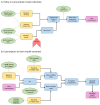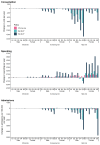Alcohol policy and gender: a modelling study estimating gender-specific effects of alcohol pricing policies
- PMID: 33651444
- PMCID: PMC7611454
- DOI: 10.1111/add.15464
Alcohol policy and gender: a modelling study estimating gender-specific effects of alcohol pricing policies
Abstract
Aims: To describe gender differences in alcohol consumption, purchasing preferences and alcohol-attributable harm. To model the effects of alcohol pricing policies on male and female consumption and hospitalizations.
Design: Epidemiological simulation using the Sheffield Alcohol Policy Model version 4.
Setting and participants: Adults aged 18+ years, England.
Interventions: Three alcohol pricing policies: 10% duty increase and minimum unit prices (MUP) of £0.50 and £0.70 per UK unit.
Measures: Gender-specific baseline and key outcomes data: annual beverage-specific units of alcohol consumed and beverage-specific alcohol expenditure (household surveys). Alcohol-attributable hospital admissions (administrative data). Key model parameters: literature-based own- and cross-price elasticities for 10 beverage-by-location categories (e.g. off-trade beer). Sensitivity analysis with new gender-specific elasticities. Literature-based risk functions linking consumption and harm, gender-disaggregated where evidence was available. Population subgroups: 120 subgroups defined by gender (primary focus), age, deprivation quintile and baseline weekly consumption.
Findings: Women consumed 59.7% of their alcohol as off-trade wine while men consumed 49.7% as beer. Women drinkers consumed fewer units annually than men (494 versus 895) and a smaller proportion of women were high-risk drinkers (4.8 versus 7.2%). Moderate drinking women had lower hospital admission rates than men (44 versus 547 per 100 000), but rates were similar for high-risk drinking women and men (14 294 versus 13 167 per 100 000). All three policies led to larger estimated reductions in consumption and admission rates among men than women. For example, a £0.50 MUP led to a 5.3% reduction in consumption and a 4.1% reduction in admissions for men but a 0.7% reduction in consumption and a 1.6% reduction in hospitalizations for women.
Conclusion: Alcohol consumption, purchasing preferences and harm show strong gender patterns among adult drinkers in England. Alcohol pricing policies are estimated to be more effective at reducing consumption and harm for men than women.
Keywords: Alcohol policy; gender; inequalities; modelling; policy appraisal; pricing; taxation.
© 2021 The Authors. Addiction published by John Wiley & Sons Ltd on behalf of Society for the Study of Addiction.
Conflict of interest statement
Figures




Comment in
-
Commentary on Meier et al.: Gender disparities in the effects of alcohol pricing policies on consumption and harm reduction.Addiction. 2021 Sep;116(9):2385-2386. doi: 10.1111/add.15569. Epub 2021 May 28. Addiction. 2021. PMID: 34048100 No abstract available.
Similar articles
-
Estimated Effects of Different Alcohol Taxation and Price Policies on Health Inequalities: A Mathematical Modelling Study.PLoS Med. 2016 Feb 23;13(2):e1001963. doi: 10.1371/journal.pmed.1001963. eCollection 2016 Feb. PLoS Med. 2016. PMID: 26905063 Free PMC article.
-
Effects of minimum unit pricing for alcohol on different income and socioeconomic groups: a modelling study.Lancet. 2014 May 10;383(9929):1655-1664. doi: 10.1016/S0140-6736(13)62417-4. Epub 2014 Feb 10. Lancet. 2014. PMID: 24522180 Free PMC article.
-
Potential effects of minimum unit pricing at local authority level on alcohol-attributed harms in North West and North East England: a modelling study.Southampton (UK): NIHR Journals Library; 2021 Mar. Southampton (UK): NIHR Journals Library; 2021 Mar. PMID: 33764725 Free Books & Documents. Review.
-
Modelling the effects of alcohol pricing policies on alcohol consumption in subpopulations in Australia.Addiction. 2020 Jun;115(6):1038-1049. doi: 10.1111/add.14898. Epub 2020 Jan 14. Addiction. 2020. PMID: 31943464
-
Pricing as a means of controlling alcohol consumption.Br Med Bull. 2017 Sep 1;123(1):149-158. doi: 10.1093/bmb/ldx020. Br Med Bull. 2017. PMID: 28910991 Review.
Cited by
-
Impact of minimum unit pricing on alcohol-related hospital outcomes: systematic review.BMJ Open. 2023 Feb 3;13(2):e065220. doi: 10.1136/bmjopen-2022-065220. BMJ Open. 2023. PMID: 36737089 Free PMC article.
-
Modifiable risk factors of inequalities in hypertension: analysis of 100 million health checkups recipients.Hypertens Res. 2024 Jun;47(6):1555-1566. doi: 10.1038/s41440-024-01615-9. Epub 2024 Mar 5. Hypertens Res. 2024. PMID: 38443615
-
[Potential impact of increased alcohol taxes on the alcohol-attributable burden of disease in Germany: a modelling study].Bundesgesundheitsblatt Gesundheitsforschung Gesundheitsschutz. 2022 Jun;65(6):668-676. doi: 10.1007/s00103-022-03528-9. Epub 2022 Apr 19. Bundesgesundheitsblatt Gesundheitsforschung Gesundheitsschutz. 2022. PMID: 35441234 Free PMC article. German.
-
The distribution of alcohol-attributable healthcare encounters across the population of alcohol users in Ontario, Canada.Prev Med Rep. 2023 Aug 25;35:102388. doi: 10.1016/j.pmedr.2023.102388. eCollection 2023 Oct. Prev Med Rep. 2023. PMID: 37691889 Free PMC article.
-
Gender differences in changes in alcohol consumption achieved by free provision of non-alcoholic beverages: a secondary analysis of a randomized controlled trial.BMC Public Health. 2024 Jan 10;24(1):150. doi: 10.1186/s12889-024-17645-4. BMC Public Health. 2024. PMID: 38200433 Free PMC article. Clinical Trial.
References
-
- Fitzgerald N, Angus K, Emslie C, Shipton D, Bauld L. Gender differences in the impact of population-level alcohol policy interventions: evidence synthesis of systematic reviews. Addiction. 2016;111(10):1735–47. - PubMed
-
- Babor TF. Alcohol: No Ordinary Commodity. OUP Oxford; Oxford: 2010.
-
- Wagenaar AC, Salois MJ, Komro KA. Effects of beverage alcohol price and tax levels on drinking: a meta-analysis of 1003 estimates from 112 studies. Addiction. 2009;104(2):179–90. - PubMed
Publication types
MeSH terms
Grants and funding
LinkOut - more resources
Full Text Sources
Other Literature Sources
Medical

